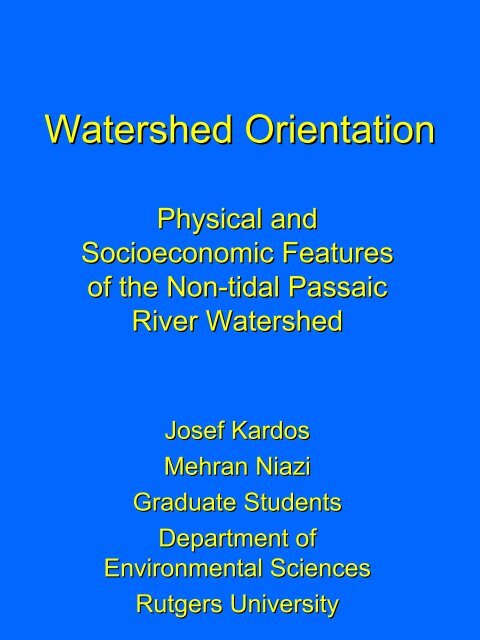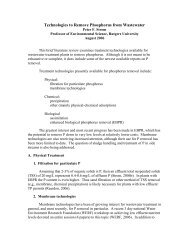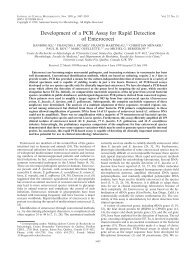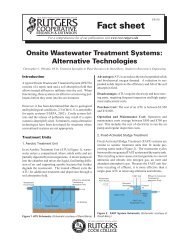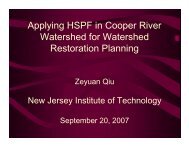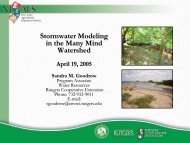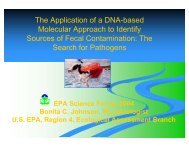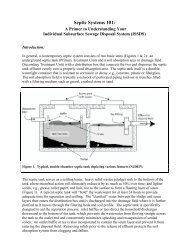Watershed Orientation, Physical and Socioeconomic Features of the ...
Watershed Orientation, Physical and Socioeconomic Features of the ...
Watershed Orientation, Physical and Socioeconomic Features of the ...
You also want an ePaper? Increase the reach of your titles
YUMPU automatically turns print PDFs into web optimized ePapers that Google loves.
<strong>Watershed</strong> <strong>Orientation</strong><strong>Physical</strong> <strong>and</strong><strong>Socioeconomic</strong> <strong>Features</strong><strong>of</strong> <strong>the</strong> Non-tidal PassaicRiver <strong>Watershed</strong>Josef KardosMehran NiaziGraduate StudentsDepartment <strong>of</strong>Environmental SciencesRutgers University
Presentation Outline• Non-tidal Passaic River<strong>Watershed</strong>• WMAs 3, 4, 6 characterization2
<strong>Orientation</strong> to:Non-tidalPassaic River basin• <strong>Watershed</strong> location• Natural features• L<strong>and</strong> use• <strong>Socioeconomic</strong> features• Water quality status• WWTPs• Surface water diversions• Sampling points3
<strong>Orientation</strong> to:WMAs 3, 4, 6– L<strong>and</strong> Use status– L<strong>and</strong> Use change over 10years– Sources <strong>and</strong> Destinations <strong>of</strong>Water Diversion– Population change over 10years– Point vs Non-point loading towaterways4
<strong>Watershed</strong> Location5
Percent <strong>of</strong> Non-tidalPassaic Basin Areavs. State92%8%StateNT-Passaic7
Percent <strong>of</strong> <strong>Watershed</strong>Area in NJ vs. NY83%17%NJNY9
Portion <strong>of</strong> WMAs inNT-Passaic RiverBasin10%36%54%WMA6 WMA3 WMA413
Natural <strong>Features</strong>14
L<strong>and</strong> Use22
L<strong>and</strong> Use Change from 1986 to 199525155-5-1523-2.58 1.03-22-15.13-4.6417.96.5 4.13-2.571.11-2.33-25Percentsq. mi.AgricultureBarren L<strong>and</strong>ForestUrbanWaterWetl<strong>and</strong>sq. mi.Percent24
<strong>Socioeconomic</strong><strong>Features</strong>25
Water QualityStatus30
Lakes & ReservoirsClassification in <strong>the</strong> NJ<strong>Watershed</strong> (Total 24.5 sq. mi.)70%30%C1C232
Stream Classification in <strong>the</strong>NJ <strong>Watershed</strong>(Total 1289 miles)76%22%2%ONRW C1 C233
NJDEP 2004 Integrated Report:Phosphorus Status in non-tidalPassaic River Basin (miles)10955.811375142Impaired Insufficient data Attain List 4 Not assessed36
WWTPs37
Surface WaterDiversions44
WWTPs <strong>and</strong> Drinkingwater intake points• 2 intake points directlydownstream <strong>of</strong> WWTPs– Wanaque South Pump Station– PVWC Treatment Plant /Pump Station47
See Appendix 635 (250)[Newark, Bayonne, o<strong>the</strong>rs]16 (150)96 (138)0.7 (NA)0.85 (0.7)47 (75)NA (50)24 (35)[Newark]47 (49)7.7 (NA)0.7 (4)7.2 (NA)6.2 (11)[Jersey City]47.8 (56.8)Average (Max) in MGDNASeasonal DiversionInter-basin transferIntra-basin transferNot Available48
Wanaque ReservoirHydrologic LoadingBudget1993-2002SourceTributarywatershedRamapo RiverPompton RiverPassaic RiverPercent <strong>of</strong>HydrologicBudget71%7%16%6%Source: NJDEP Phase I TMDL (proposed)51
Sampling Points


